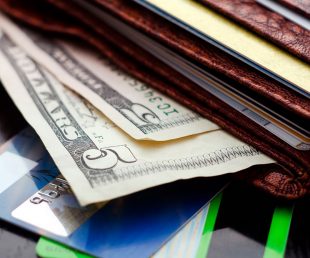As inflation increases the price of goods and services, consumers face the challenge of spending more to get the same—or less. This rings true for everything from gas to rent to food. For some, credit cards have helped fill the gap. Consider that U.S. credit card debt reached $890 billion in the second quarter of 2022. That’s a 13% increase from the previous year, and the largest annual increase in more than 20 years, according to a report from the Federal Reserve Bank of New York.
So, while rising prices don’t directly impact your credit score, using credit to pay for increased expenses most certainly can. The increased cost of things can lead to overspending—even if you’re simply trying to sustain your current expenses. What’s more, as the Fed increases interest rates, the Annual Percentage Rate (APR) on most credit cards will rise as well.
Increasing your use of available credit and making late payments can negatively impact your credit score, meaning short-term spending can become a long-term problem. Fortunately, you can take steps to manage your credit even as prices rise.
Managing credit during inflation
There’s no doubt that rising prices can easily lead to added spending on your credit card. Filling your gas tank costs significantly more than it did a year ago. Your grocery bill has likely been on the rise. And your rent may have even increased due to the short supply of housing around the country.
However, managing your spending is critical to protecting your personal finances during times of inflation. The following steps can help protect your finances:
- Understand your spending. If you don’t already, take advantage of a budgeting, mobile banking, or credit card app to understand where your money goes. You may be surprised to see what’s been impacted by inflation. You may also find places where you can cut back without much pain.
- Pay your balance in full each month. The Fed is raising interest rates to battle inflation, which means credit card rates are going up, too. Avoid incurring even more debt—your spending plus interest—by paying off your balance each month.
- Reduce your interest rates. Review your credit cards and compare the interest rate of each. Reach out to your lender to ask for a rate reduction on some of your highest cards.
- Consider cash. If controlling your credit card spending proves too challenging, consider paying daily expenses with cash. You can set aside how much you have to spend weekly—and when your cash runs out, you’re done.
Improve your credit score
The current inflation may hurt the economy, but your credit score can emerge unscathed—or even improve. Here are some ways to preserve and even increase your credit score:
- Reduce your credit utilization. Your credit utilization ratio refers to the amount of debt you have on your credit card(s) compared to your total credit limit. The credit bureaus usually advise that consumers keep their credit utilization ratios below 30%. You can either pay down your debt or ask lenders to increase your credit limit to improve your credit score.
- Make your payments on time. If making late payments has been a pattern, there’s no time like the present to change. Payment history accounts for 35% of your overall credit score. So prioritize paying off any past due bills and start a new habit of paying your credit card bills on time.
- Limit new credit applications. Hard inquiries to your credit report from lenders can hurt your credit score. While you’re focused on managing your credit and improving your score, keep your applications for new credit cards to a minimum.
What to do about debt
Paying your credit card bills on time is essential to maintaining a healthy credit score. But sometimes other financial emergencies take precedence, and paying your credit card bills becomes a challenge. Fortunately, you can take action to help get yourself out of debt and back on financial track.
If you’re struggling with late payments, consider the following:
- Connect with your lenders. They may be able to lower your monthly payment or negotiate other concessions, such as a lower interest rate. All of these make it possible for you to pay down your debt that much faster.
- Consolidate your debt. Combining multiple debts onto one credit card may reduce your interest rates (as mentioned above) and make it easier to track your debt. You can pay your bills off with one payment each month and eliminate confusion caused by multiple cards.
- Remove late payments from your report. If you have a late payment on your report and you’ve paid it off, you can write a goodwill letter to your creditor to ask that they remove it. Explain why the payment was late and note that you paid the bill in full and that you won’t pay late again.
Inflation certainly poses challenges to spending and saving. But don’t let your credit score take the hit. Focus on managing spending, improving your score, and eliminating late payments. You’ll sidestep any adverse impacts on your credit score and emerge stronger than before.
This article is for promotional purposes only. Santander Bank, N.A. (“Santander”) does not provide investment, business, financial, accounting, tax, or legal advice, and the content of this article does not constitute investment, business, financial, accounting, tax, or legal advice. Santander does not make any claims, promises, or guarantees about the accuracy, completeness, currency, or adequacy of any content. Santander expressly disclaims all express and implied warranties of accuracy, completeness, currency, or adequacy of the information and content in this article. Readers should consult their own attorneys or tax or other advisors regarding the applicability of any referenced information or financial or other strategies to their own unique circumstances. This article does not necessarily reflect the views or endorsement of Santander.
Santander Bank, N.A. is a Member FDIC and a wholly owned subsidiary of Banco Santander, S.A. ©2022 Santander Bank, N.A. All rights reserved. Santander, Santander Bank, and the Flame Logo are trademarks of Banco Santander, S.A. or its subsidiaries in the United States or other countries. All other trademarks are the property of their respective owners.
![]()


